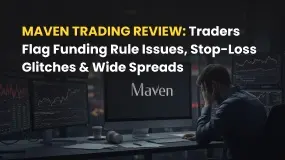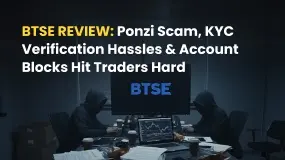简体中文
繁體中文
English
Pусский
日本語
ภาษาไทย
Tiếng Việt
Bahasa Indonesia
Español
हिन्दी
Filippiiniläinen
Français
Deutsch
Português
Türkçe
한국어
العربية
Top 10 Trading Indicators Every Forex Trader Should Know
Abstract:Master the top 10 Forex trading indicators to analyze real-time Forex quotes, trends, and market signals. Learn strategies to boost accuracy and avoid mistakes.

Top 10 Trading Indicators Every Forex Trader Should Know
Forex trading may be as profitable as it is difficult. The global currency market is open around the clock, and traders want dependable tools to keep up with market fluctuations. Trading indicators are unique in their ability to simplify complicated market data and deliver actionable information. Knowing how to utilize these indicators, whether you're evaluating real-time forex quotations or planning your next transaction, may help you perform better.
What Are Forex Trading Indicators?
Trading indicators are essential instruments for interpreting financial data, and providing insights into market patterns, volatility, and trading possibilities. To forecast likely future behaviors, they analyze previous price movements, volume, and other market variables. These tools serve as the cornerstone for many trading techniques, allowing traders to spot trends, pinpoint entry and exit locations, and estimate risk levels.
In forex trading, where real-time currency quotations fluctuate quickly, indicators give clarity in a fast-paced market, allowing traders to make informed judgments rather than guessing.
What Role Do Indicators Play in Forex Trading?
Forex indicators serve a variety of objectives, all of which are intended to enhance trading results. They support:
1. Recognize Market Trends: Identifying whether a currency pair is going higher, downward, or remaining range-bound is critical for developing a strategy.
2. Spot Entry and Exit Points: Indicators identify the optimal periods to enter or quit a transaction, increasing profits and avoiding losses.
3. Improving Risk Management: Indicators help with risk management by providing tools such as stop-loss and take-profit advice.
4. Save Time and Avoid Mistakes: Automated analysis using indicators makes market evaluation easier, allowing traders to focus on strategy rather than numbers.
Traders may convert apparently chaotic markets into organized opportunities by utilizing indicators.

Types of Forex Indicators You Should Know
There are four sorts of forex indicators, each providing a distinct role in trading analysis.
1. Trend Indicators: Examples are Moving Averages and Bollinger Bands, which reflect the direction and intensity of market trends. They're great for determining if the market is bullish, bearish, or consolidating.
2. Momentum Indicators: The Relative Strength Index (RSI) and Stochastic Oscillator are two tools used to quantify the speed and intensity of market changes. They aid traders in identifying overbought or oversold situations.
3. Volatility Indicators: Indicators such as the Average True Range (ATR) reflect the magnitude of price variations, providing traders with an understanding of market activity and potential breakout possibilities.
4. Volume Indicators: Tools such as On-Balance-Volume (OBV) analyze trade volume to determine the strength of trends, which are frequently a prelude to price moves.
Each sort of indicator offers a distinct viewpoint, and combining them can provide a comprehensive picture of market circumstances.
How to Maximize Profit with Trading Indicators
Follow these tactics to maximize the use of trading indicators:
1. Pair Indicators with Market Context: When reading indicator signals, always take into account economic news and other external variables.
2. Testing on Historical Data: Before using an indicator in live trading, test it on previous market data to see how successful it is.
3. Make It Simple: A crowded chart with an excessive number of markers might cause misunderstanding. Concentrate on two or three indications that are relevant to your trading aims.
Combining a trend indicator like Moving Averages with a momentum indicator like RSI, for example, might produce more accurate buy or sell recommendations. Traders can acquire information that individual indicators may not provide.
Commonly Used Forex Trading Indicators Explained
The most prominent Forex trading indicators and their applications are listed below:
1. Moving Averages (MA): Smooth out price data to highlight long-term trends.
2. MACD (Moving Average Convergence Divergence): Combines trend and momentum data for versatile insights.
3. Relative Strength Index (RSI): Evaluates whether a currency pair is overbought or oversold.
4. Bollinger Bands: Identifies periods of high volatility and potential breakout zones.
5. Stochastic Oscillator: Measures market momentum to identify potential reversals.
6. Fibonacci Retracement: Helps determine support and resistance levels during price corrections.
7. ATR (Average True Range): Assesses the volatility of currency pairs.
8. Ichimoku Cloud: A comprehensive indicator that provides a holistic view of trends, momentum, and support/resistance.
9. Parabolic SAR: Useful for pinpointing potential trend reversals.
10. On-Balance Volume (OBV): Tracks volume changes to anticipate price direction.
Combining Indicators for More Effective Forex Trading Signals
Using a variety of indicators can provide more precise trading indications.
1. Pairing RSI with Bollinger Bands can reveal probable breakout points in overbought or oversold circumstances.
2. Combining MACD and Moving Averages indicates trends' strength and direction.
Avoid employing too many indicators at the same time, since this might result in contradicting messages. To make decision-making easier, focus on the synergy between your tools.

Avoiding Mistakes When Using Forex Indicators
Even the most effective instruments may be abused. To avoid the following typical mistakes:
1. Overreliance on Indicators: Indicators are recommendations, not promises. They should be used in conjunction with your entire trading strategy, not instead of it.
2. Neglecting Market News: Indicators fail to account for geopolitical events or economic data releases, which have a significant impact on Forex markets.
3. Overcomplicating Charts: Charts that are overly complicated Too many signs might be overwhelming and lead to analytical paralysis.
For balanced decision-making, use a simplified strategy that incorporates both technical and fundamental analysis.
Final Thoughts
Mastering Forex trading indicators is a critical step towards becoming a confident and effective trader. These tools, whether used to assess real-time forex quotations or analyze patterns, give crucial insights that help to clarify market difficulties. However, indicators should be used as part of a larger trading strategy that incorporates risk management, market news research, and emotional discipline.
Understanding their purpose and use will allow you to discover fresh possibilities in the Forex market and trade more accurately. Begin slowly, practice regularly, and see your trading abilities and results grow over time.

Disclaimer:
The views in this article only represent the author's personal views, and do not constitute investment advice on this platform. This platform does not guarantee the accuracy, completeness and timeliness of the information in the article, and will not be liable for any loss caused by the use of or reliance on the information in the article.
Read more

Maven Trading Review: Traders Flag Funding Rule Issues, Stop-Loss Glitches & Wide Spreads
Are you facing funding issues with Maven Trading, a UK-based prop trading firm? Do you find Mavin trading rules concerning stop-loss and other aspects strange and loss-making? Does the funding program access come with higher spreads? Does the trading data offered on the Maven Trading login differ from what’s available on the popular TradingView platform? These are some specific issues concerning traders at Maven Trading. Upset by these untoward financial incidents, some traders shared complaints while sharing the Maven Trading Review. We have shared some of their complaints in this article. Take a look.

BTSE Review: Ponzi Scam, KYC Verification Hassles & Account Blocks Hit Traders Hard
Have you lost your capital with BTSE’s Ponzi scam? Did the forex broker onboard you by promising no KYC verification on both deposits and withdrawals, only to be proven wrong in real time? Have you been facing account blocks by the Virgin Islands-based forex broker? These complaints have become usual with traders at BTSE Exchange. In this BTSE review article, we have shared some of these complaints for you to look at. Read on!

Inzo Broker Review 2025: Is It Legit or a High-Risk Gamble?
When you ask, "Is inzo broker legit?" you want a clear, straight answer before putting your money at risk. The truth about Inzo Broker is complicated. Finding out if it's legitimate means looking carefully at its rules, trading setup, and most importantly, the real experiences of traders who have used it. The broker shows a mixed picture - it has official paperwork from an offshore regulator, but it also has many user warnings about how it operates. This review gives you a fair and fact-based investigation. We will break down all the information we can find, from company records to serious user complaints, so you can make your own clear decision.

INZO Broker No Deposit Bonus: A 2025 Deep Dive into Its Offers and Risks
Traders looking for an "inzo broker no deposit bonus" should understand an important difference. While this term is popular, our research shows that the broker's current promotions focus on a $30 welcome bonus and a 30% deposit bonus, rather than a true no-deposit offer. A no-deposit bonus usually gives trading funds without requiring any capital from the client first. In contrast, welcome and deposit bonuses often have rules tied to funding an account or meeting specific trading amounts before profits can be taken out. This article gives a complete, balanced look at INZO's bonus structure, how it operates, and the major risks shown by real trader experiences. Read on!
WikiFX Broker
Latest News
Forex Expert Recruitment Event – Sharing Insights, Building Rewards
Admirals Cancels UAE License as Part of Global Restructuring
Moomoo Singapore Opens Investor Boutiques to Strengthen Community
OmegaPro Review: Traders Flood Comment Sections with Withdrawal Denials & Scam Complaints
An Unbiased Review of INZO Broker for Indian Traders: What You Must Know
Is Fyntura a Regulated Broker? A Complete 2025 Broker Review
PINAKINE Broker India Review 2025: A Complete Guide to Safety and Services
Is Inzo Broker Safe or a Scam? An Evidence-Based Analysis for Traders
Is Uniglobe Markets Legit? A 2025 Simple Guide to Its Safety, Services, and User Warnings
Is Forex Zone Trading Regulated and Licensed?
Currency Calculator



